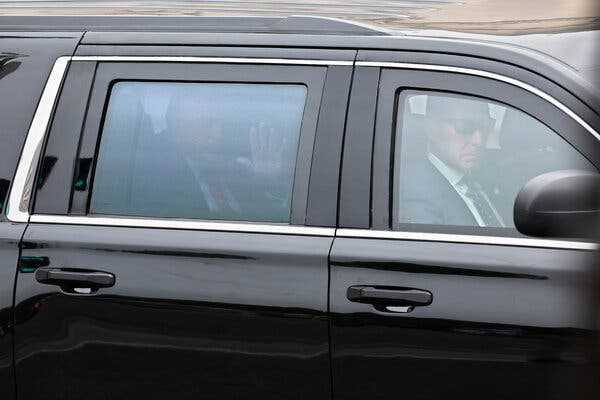A quick proceeding that was mostly straightforward.
- Give this article

Former President Donald J. Trump waving as he departs the Federal District Court in Washington on Thursday.
Former President Donald J. Trump appeared before a federal magistrate judge in Washington on Thursday, the third time in four months he has stood to face criminal charges.
He pleaded not guilty to allegations that he illegally tried to hold on to power and overturn President Biden’s victory in the 2020 election. In June, he was arraigned in Miami on federal charges of mishandling government documents after he left the White House and seeking to block investigators. In April, he appeared in Manhattan to address accusations that he orchestrated a hush-money scheme. He pleaded not guilty to more than 70 charges.
Thursday’s appearance was mostly straightforward. Here are some key takeaways:
The conditions of his release will not prevent Mr. Trump from campaigning, but could limit his communications.
It was no surprise that Mr. Trump pleaded not guilty. As in the Miami case, the government did not request bail and did not place restrictions on his travel as a condition of his release. He was not asked to surrender his passport.
Mr. Trump agreed to not discuss the case with anyone he knows to be a witness, except through counsel or in the presence of counsel. The same order was imposed in the documents case.
He also agreed to not violate federal or state law, and to appear in court as directed. Failure to comply could result in an arrest warrant and the conditions of his release being revoked, opening the possibility that he could be held until trial and charged with contempt of court.
The judge, Magistrate Judge Moxila A. Upadhyaya, noted that Mr. Trump must not retaliate against witnesses or otherwise obstruct the administration of justice.
ImageAlina Habba, a lawyer for Mr. Trump, outside the Federal District Court in Washington on Thursday.Credit…Doug Mills/The New York Times
The defense is expected to delay as much as possible.
Judge Upadhyaya offered three possible dates for a first hearing: Aug. 21, Aug. 22 and Aug. 28. Prosecutors requested the earliest date, while Mr. Trump’s lawyers requested the latest.
The hearing was set for Aug. 28, five days after the first Republican debate in the 2024 presidential contest. Mr. Trump has not said yet whether he intends to participate.
Judge Upadhyaya ordered the government to file a brief next week that would propose a trial date and estimate how long its case will take. Seven days after that, Mr. Trump’s lawyers will file their proposal.
The timing of the trial is inevitably tied up in political concerns, as Mr. Trump will be expected to make courtroom appearances in his multiple trials while other Republican presidential candidates will be able to focus on debates and appearances in primary states.
Once again, no visual images emerged from the proceedings.
Mr. Trump entered and exited the courthouse through an entrance inaccessible to the public. His motorcade drove past a modest crowd of supporters each way without stopping.
No visual images were publicly recorded of the events except for a court sketch: Photographers were not permitted inside the courtroom, and no mug shot was taken. Just a small handful of reporters were in the courtroom to observe. (Others were able to watch from a room nearby, but the live video was not available to the public.)
It was similar to how events played out in Miami in June, during which the only images that later appeared were court sketches. After that hearing, Mr. Trump made a campaign stop at a popular Cuban restaurant.
There is little clarity on what it will mean for his 2024 presidential campaign.
Mr. Trump’s popularity among his Republican base has proved to be durable after the two prior indictments. Earlier this week, the first New York Times/Siena College poll of the 2024 campaign showed him with a landslide lead of 37 percentage points over Gov. Ron DeSantis of Florida, his closest competitor in the Republican primary.
His other indictments have corresponded to large spikes in fund-raising. On Thursday, hours before appearing in court, Mr. Trump wrote in an all-caps message on Truth Social, the social network he founded: “I need one more indictment to ensure my election!”
Daniel Victor is a senior editor for live news based in New York after stints in London and Hong Kong. He joined The Times in 2012. More about Daniel Victor
- Give this article
SKIP ADVERTISEMENT
Source: nytimes.com



